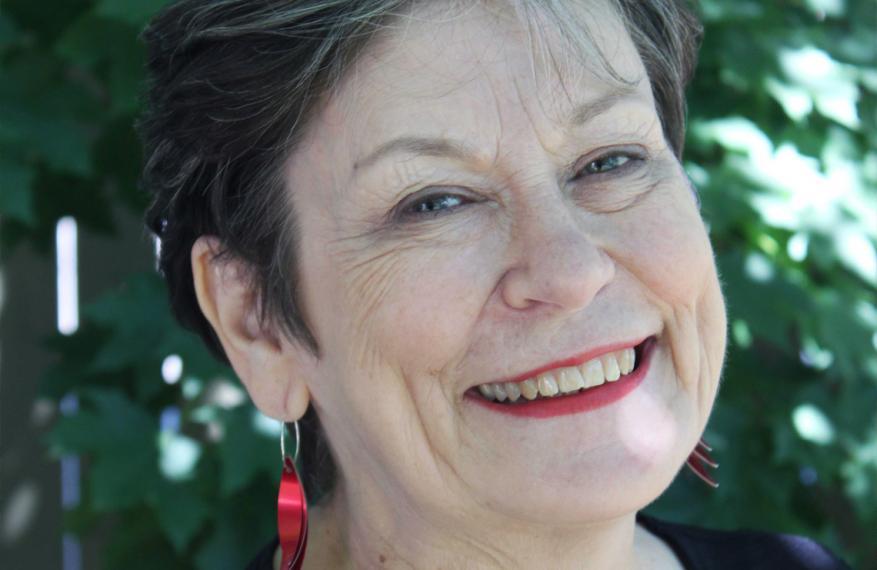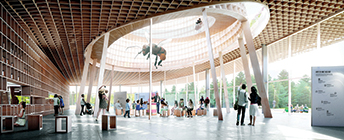An architect for nature

We see them every day, all around us: the interconnections between the natural and humanmade worlds. A lot of hard work and critical thought have gone into the design of parks, school playgrounds and local streets. But who did this work? Most likely a landscape architect.
Colleen Mercer Clarke describes the profession of landscape architecture as “being architects for nature.”
“Landscape architects bridge the gap between the built and natural environment,” says Colleen. “We have a consciousness for both. In our work, we consider the needs and well-being of society but also the needs of ecosystems, habitats and species.”
A landscape architect’s work can range from community planning and agricultural urbanism to heritage conservation and green infrastructure. The work is diverse and can vary greatly. In a time when environmentalism is critical, landscape architects are doing their part to ensure a sustainable future.
“As landscape architects, we are looking ahead at least one generation,” says Colleen. “What we build is intended to last long beyond our lifetime. Our goal is to pass things on in better shape then they were given to us.”
Colleen has certainly lived up to this commitment. Today she chairs the Canadian Society of Landscape Architects committee on climate adaptation, and co-chairs the International Federation of Landscape Architects working group on climate change.
Throughout her career, she has worked on environmental management initiatives, environmental audit and impact assessments, and detailed site designs. She has conducted environmental assessments of offshore oil and gas and hydroelectric generation, and has been instrumental in the assessment, planning and rehabilitation of contaminated lands, such as the Sydney Tar Ponds in Nova Scotia.
It is safe to say that her entire career has involved protecting the environment, but she only began focusing on climate change resilience in 2009.
“Climate change is marching so quickly and devastatingly towards us. We really needed to be paying attention a long time ago,” she says.
Colleen started working in environmental sustainability shortly after graduating from the University of Guelph. Throughout the 1990s, she worked extensively in this area, even though it was often a low priority politically at the time.
“The environment is critical to our society and so is economic prosperity. The two have always walked hand-in-hand, but it hasn’t always been an easy sell. Some governments believed you had to decide between the two: that you could either have economic prosperity and jobs or you could protect the environment.”
A passion for the environment was instilled in Colleen from birth. She was born and raised in Gander, N.L., where her family is rooted around the ocean, the coast and fishing.
“Growing up, I had a thirst to be by the seashore – and it stayed with me.”
As an ecology student Colleen remembers a professor telling her that she was one of several students with “a fire in their belly for the natural world,” and she pursued this passion as a marine ecologist for more than 10 years.
That same fire drove Colleen to apply to the University of Guelph’s Master of Landscape Architecture (MLA) program for her second master’s degree.
“In environmental assessment, you do a lot of science and a lot of investigation, but recommendations are kind of like a check box and then you move on,” she says. “I wasn’t sure if any of the reports were being read.”
She thought pursuing her MLA would mean leaving the “hard-edged” science behind, but that wasn’t the case. It was a shift in her mindset that would be the biggest change.
“Ecologists are observers, recorders and reporters. In contrast, landscape architects are problem solvers. You really see the world differently; you see your role in the world differently. As a landscape architect, you look at a situation and look for the best resolution – one that can bring the most artful design and the most sustainable construction and operation.”
She quickly discovered that her experience as an ecologist would help in her landscape architect career.
“Being both an ecologist and landscape architect enabled my work in environmental assessment, in ways I had not anticipated. The hiring audience saw it as a real asset.”
“We have a lot of climatologists and meteorologists, but it is difficult for them to communicate what they know to decision-makers who are going to do something about it. What we really need, and this is where my landscape architecture background has come to the fore, is good communicators. We need people whose work is vested in the science and who can pick it up and translate it to human society to make it useful.”
It is in this need for translation that Colleen believes environmentalism could take a page out of agriculture’s book.
“A colleague in climate adaptation from Charlottetown once recounted to me the parallels between adaptation and farming, saying: ‘I’m a pig farmer. When one of my pigs gets sick and we can’t figure out what is wrong, we work with experts from Agriculture and Agri-Food Canada to figure it out. What we need here [in climate change] is a liaison officer.’”
Agriculture has evolved throughout history; the way humans care for animals, tend to soil and crops and use technology is ever changing. By working together and sharing knowledge agriculture has and will continue to be sustained to produce the food we need to survive.
According to Colleen, the approach to caring for the planet should be no different.
“In landscape architecture, we are trying to identify the sources of new and evolving information and connect that to decision-makers. We provide the interpretation and guidance that is needed to ensure this happens, on a local, national and
international level.”
After 35 years of environmental work, Colleen remains optimistic about the future.
“Not everything about climate change is bad. There will be new opportunities as well as new challenges. Landscape architects are well poised to become leaders in this field, working with interdisciplinary teams to find the best solutions for environments and for people.”
This article was originally published in the LIBRANNI 2020 / Vol. 2
 |
Learn more about OAC research:Building a new hive
|
 |
Learn more about OAC research:Planning for the future |